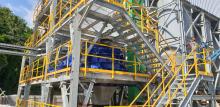The new RPMF machines from the German manufacturer are said to produce even finer fractions, as well as output material with a significantly higher proportion of fine sand. As such, machines of this type are more efficient in producing crushed sand.
The RPMF design is a variant of the rotor impact mills of type RPM, which are known in the industry as ‘sand makers.’ BHS designed both types of machines to be used primarily with pre-crushed, brittle and mildly abrasive materials such as limestone. Impact crushing has proven to be the best method for crushing these kinds of materials.
BHS-Sonthofen developed the new machine type specifically for finer output sizes. Thanks to a longer, narrower milling gap and increased circumferential speed (of up to 90m/s) in the rotor, machines of type RPMF archive higher reduction ration than other machines do. As a result, they provide users with output material that contains a higher proportion of fine-sand.
Ludwig Bechteler, sales director of mixing technology at BHS, oversaw testing for the new machines: “The tests conducted in our technology center demonstrated that RPMF machines produce a significantly higher proportion of usable fine sand in the grain-size range of 0 to 1 mm than rotor impact mills of type RPM do. For example, RPMFs produce over 50 percent more usable dry mortar sand.”
The new machines of type RPMF also feature a significantly narrower gap between the grinding tools and the anvil ring. The gap width can be set to a minimum of 5mm.
The new machines yield significantly more fine sand and make plants more efficient in producing sand by reducing the return flow of coarse material, which in turn reduces the number of times that material needs to pass through the mills. This also means that these machines require less screening and conveyor technology. Moreover, since they produce finer feed material, these machines reduce workloads for ball mills, which can crush material to a particle size of under 40µm.
The feed material can have a particle size of up to 32mm. A BHS rotor impact mill of type RPM can be used to pre-crush feed fractions up to 56mm.
BHS-Sonthofen produces the new rotor impact mills of type RPMF in two different designs:
• RPMF1116, which has a circumferential speed of up to 90 m/s and a throughput of up to 25 tonnes/hour
• RPMF1516, which has a circumferential speed of up to 90 m/s and a throughput of up to 55 tonnes/hour
The RPMF machines combine high rotation speeds and a narrower milling gap, so the engineers who designed them needed to control significantly greater centrifugal forces while maintaining a tighter production tolerance.
The feed material is inserted into the machine from above via the central feed-in pipe. When it impacts with the rotor, the material is accelerated towards the outside through centrifugal forces; there, the horseshoe-shaped hammers hit it and throw it against the anvil ring. As the material impacts with the ring, it is subjected to impact and shear forces that crush it. After the material rebounds from the anvil ring, it comes into contact with the hammers once again, which further crush it and throw it back against the anvil ring. The process is repeated multiple times, subjecting the feed material to intense stress. The material leaves the rotor through the gap between the rotor and the anvil ring, falling down through the two outlet chutes.
The mill can be operated alternately clockwise and counter-clockwise, which reduces wear on the hammers. Easy-to-replace spacers allow the operator to modify the milling gap in accordance with the wear on the impact hammers.









